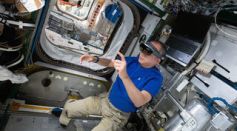Tags: Virtual Reality

Virtual Reality Therapy Makes People With Psychosis Confident Leaving Home and Engaging in Real-Life Activities

Are Police Needed in Virtual Reality? Crime, Sexual Exploitation Still a Concern in Metaverse

Metaverse Dating: Why Romantic Experience in Virtual Reality is More 'Immersive' Than Online Courtship?

Immersive Virtual Shopping A Potential Solution to Cognitive Assessment, Study Says

Cows Use VR Goggles Tricking Them Into Thinking Its Summer to Reduce Stress, Anxiety and Produce More Milk

Facebook Will Get a New Name Soon; Mark Zuckerberg's Rebranding Scheme Focused on the Metaverse
Zebrafish Can Predict Future Danger; New Study Reveals They've Learned to Escape the Peril in Virtual Reality

NASA Astronauts Seek Augmented Reality Assistance to Repair ISS; How Does It Work?

AR/VR Glasses of the Future Need Not Be Bulky, Bug-Eyed with New Technology

Virtual Telepresence Robot With VR Display for Real-Time Monitoring of Remote Locations
Russian Archaeologists Create a 3D Model for a Section of the Tepsei Site

UNMC Unveils The Teaching Hospital of the Future
Virtual Reality of Wisconsin Forest Takes Strollers to 2050
Technological Breakthrough Could Make Holograms Touchable

Explore Hallett Cove in Australia, Thanks to Virtual Reality
Italy’s Furniture Giant Launches AR and VR Furniture Shopping
Taste Neurons Can Be Controlled by Green Light
Facebook’s New Virtual Reality Headset is a Game Changer
Using the Virtual Environment to Study Crime
Second Wave of Sexual Technologies Arising
Most Popular

Tornadoes vs. Waterspouts vs. Dust Devils: Key Differences and Vortex Types Explained

Elon Musk's Neuralink to Automate Brain Implant Surgeries, Plans Mass Production

Brain Health Aging Guide: Effective Strategies for Cognitive Decline Prevention and Lower Dementia Risk

Mitochondrial Health and Aging: How Cell Energy Drives Modern Anti-Aging Science





